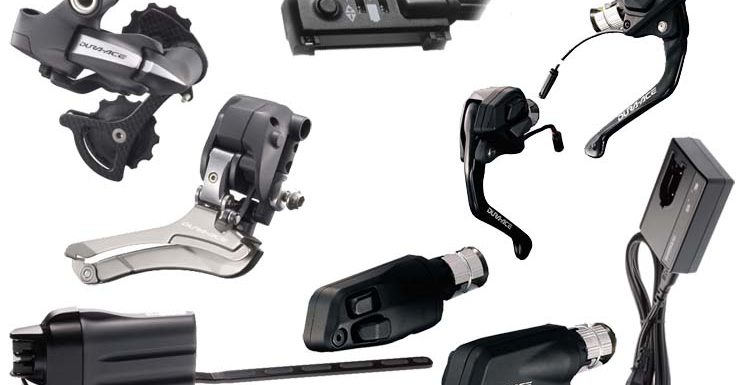
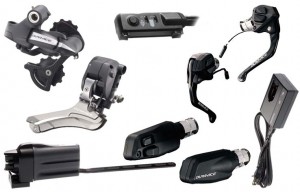 I learned quite a bit about Shimano Di2 when I installed one of the first available Time Trial/Triathlon groupsets on my Cervelo P2. I’ve subsequently answered a lot of questions on forums and article comments, and elsewhere. In doing so, I realized that people have a lot of questions about Di2 and the answers are difficult to find. This lead me to create this article, to consolidate everything I know and have been asked into one location so people can find answers. If you can’t find what you’re looking for below, please leave a comment and I’ll do my best to help.
I learned quite a bit about Shimano Di2 when I installed one of the first available Time Trial/Triathlon groupsets on my Cervelo P2. I’ve subsequently answered a lot of questions on forums and article comments, and elsewhere. In doing so, I realized that people have a lot of questions about Di2 and the answers are difficult to find. This lead me to create this article, to consolidate everything I know and have been asked into one location so people can find answers. If you can’t find what you’re looking for below, please leave a comment and I’ll do my best to help.
Index: There’s lots of info in this post, so here’s an Index to help you find specific sections:
- Di2 General Overview
- Compatibility: Between 6770 10-speed, 6780 11-speed, 9070 11-speed, first-gen 7970
- How to Check Battery Level
- How to Adjust Rear Derailleur Trim
- How to Adjust Front Derailleur Trim
- Dealer Installation Manuals
- Shimano E-tube Project Software – Change Settings and Update Firmware
- Chargers, PC USB Interfaces/Programmers
- Component Overviews
- Shift/Brake Levers
- Dedicated Shift Buttons
- Front Derailleurs
- Rear Derailleurs
- Display Units and ANT Bluetooth Wireless Communication Modules
- Batteries and Battery Mounts (Internal and External)
- Front Cable Connection A Junctions (with charger ports and LED status lights)
- Rear Cable Connect B Junctions
- Cables, Grommets, Cable Install Tools
- List of Components Needed to Build Your Own Di2 System
- Technical Details of the Di2 CANBUS protocol and signaling
System Overview: Shimano Di2 Dura-Ace 9150 and 9070 and Ultegra 6770 and 6870
The second generation Shimano Ultegra 6770/6870 and Dura-Ace 9070 “E-Tube” electronic bicycle shifting systems consist of battery-powered electric derailleurs activated by handlebar mounted push buttons. Power and shift commands are sent via a 2-wire CAN (Controller Area Network) datalink contained within a single cable housing. This design has several advantages over conventional mechanical shifting systems, the most notable of which are:
- Extremely low shifting effort, which generally results in more frequent shifts and therefore better gear ratio selection.
- Greatly improved shift quality, especially for the front derailleur chainrings, allowing shifting under full power with almost no chance of a dropped chain.
- Shifting is available at multiple positions on the handlebars, for example, at the end of the time trial aero bars, on the brake levers, up to in climbing position, and down low the sprint position.
- Automatic trimming of the front derailleur position as the rear derailleur moves back and forth between the smaller and bigger gears. This eliminates unintended contact (and noise) between the front derailleur and the chain.
- Lighter weight vs. equivalent mechanical system. The Shimano Dura-Ace Di2 9070 electronic groupset with internal battery weighs 2047 grams; the Shimano Dura-Ace 9000 mechanical groupset weighs 2074 grams (27 grams more than Di2.)
- Multi-Shift: Pressing and holding a rear derailleur shift button results in shifts through multiple gears. The rate of shifts can be configured using the PC computer interface cable and the free Shimano E-tube Project software.
- Synchronized Shifting: Starting with Dura-Ace 9150, automated Synchronized Sifting of the front derailleur is an option. Two SHIMANO Synchronized Shift modes will be available:
- Full SHIMANO Synchronized Shift: the front derailleur reacts based on the rear derailleur’s shift action. This essentially means that, when activated, there is no need for two separate shifters to control front and rear derailleurs, the two buttons on one shifter will control both derailleurs.
- Semi SHIMANO Synchronized Shift mode: the rear derailleur reacts based on the front derailleur’s shift action, shifting to the next most appropriate rear gear when the rider makes a front shift.
- R9120, R9170 – syncroshift enabled with firmware 3.2.0 or newer
- 6870, 9070 – syncroshift enabled with firmware 3.2.1 or newer
- 6770 – no syncroshift firmware update will be offered
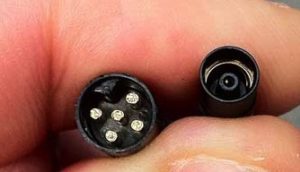 Historic Info on the older first generation 5-wire Shimano Dura-Ace Di2 DA-7970 system and how it compares to the new E-tube 2-wire system:
Historic Info on the older first generation 5-wire Shimano Dura-Ace Di2 DA-7970 system and how it compares to the new E-tube 2-wire system:
Released in 2009, the 7970 operated using a very basic 5-wire electronic system. Each shift button was connected to a different wire; shorting the specific wires together controlled the derailleur upshifts and downshifts. Because the first generation 7970 used completely different technologies than the newer 2-wire systems, none of the components are cross-compatible. At this point, Shimano is not expected to offer any updates or new components using the first generation 7970 architecture; everything from now on will be based on the newer 2-wire E-tube design. The second generation design offers several advantages, which include: 1) smaller wire size, smaller connector size, waterproof connectors; 2) all switches can be reconfigured in software to send upshift or downshift commands to either the front or rear derailleur; 3) firmware updates can add new features (such as multi-shift) and compatibility with new components.
Compatibility: Dura-Ace 9070 and Ultegra 6770 / 6870 (and old 5-conducter 7970)
The confusing naming system used by Shimano makes it difficult to figure out what each component is, much less what is compatible between systems. Here are some compatibility guidelines:
- Nothing from the first generation (4-conductor / 5-conductor) Dura-Ace Di2 7970 system is compatible with any other newer system. It was replaced by the (2-conductor) E-tube systems. No parts are inter-operable between 7970 and any other Di2 System.
- In general, every electronic Di2 component is compatible between the Ultegra 6770, 6870, and Dura-Ace 9070 systems (see exceptions below.) This means that all of the road bike Ultegra/Dura-Ace dual control brake levers/shifts, time trial shifters, and climbing shifters can be used with either Ultegra 6770/6870 or Dura-Ace 9070 front and rear derailleurs. Any of the Ultegra/Dura-Ace controllers (A Junctions) can be used with either system. All components use the same cables and connectors.
- Firmware Update Required to Make Older Components Compatible with Newer Components: If you add a new component and it doesn’t work, update the firmware using the PC USB adapter and the Shimano E-tube Project Software for Windows.
- Synchronized Shifting and Bluetooth Wireless Units can be added to all E-tube Ultegra and Dura-Ace systems but the battery has to be upgraded to the BT-DN110 Internal Battery or BM-DN100 External Battery Mount. To add Bluetooth capability, a EW-WU101 or EW-WU111 inline transmitter must be added to road bikes and for mountain bikes, the SC-MT800 or SC-M9051 display/transmitter unit must be added.
- Compatibility Exceptions:
- Note 1 – Sprint Shifter Exception: The Sprint Shifter is the only exception for shifter incompatibility. It has a different wiring connector (and internal components) that can only plug into a unique/dedicated third port on the Dura-Ace ST-9070 Dual Control Brake Levers/Shifters and also the ST-6870 Levers. There is no sprint shifter port on the ST-R785 Hydraulic Levers.
- Note 2 – Can’t mix 10-speed/11-speed front/rear Derailleurs: It is no longer possible to use a 10-speed front derailleur with an 11-speed rear derailleur (and 11-speed front with 10-speed rear.) See note farther below to read the history on this if you want all the messy details.
- Note 3 – Front A junction and Internal Battery: Since the February 2015 firmware update, the older SM-EW67-A-E Front Junction A is no longer compatible with the BTR2 Internal Battery because it does not have the charging port to charge the internal battery. The SM-EW90 Front Junction (with integrated charging port) should be used instead. The SM-EW67 still works with the external battery.
- Note 4 – Update the Firmware to make components compatible: If the firmware on all components is not updated to the latest version, some components may be not operate correctly with one another. So download the latest E-tube software and update everything and it should work.
- Note 5 – All Shifters work with all 10-speed and/or 11-speed Rear Derailleurs: All of the shifters are compatible with either the 10-speed Ultegra 6770 or 11-speed Ultegra 6870/Dura-Ace 9070 systems as long as they all have the latest firmware. The rear derailleur is the only component that “knows” or “cares” how many rear gears are available. The shifters only send upshift/downshift commands and do not “know” or “care” which gear is currently selected and how many total gears there are.
- Note 6 – SM-BTR1 External Battery and SM-BMR1 Mount firmware updates: The more expensive dedicate service tool (SM-PCE1 PC Interface) must be used to upgrade the firmware on the external battery/mount.The external battery and battery mount can not receive firmware upgrades via the SM-EW90 Front Junction A and the SM-BCR2 PC Interface/Battery Charger. (The SM-EW90 will work in a system with an external battery, but a firmware update can cause them to become incompatible until both are updated independently using the appropriate PC Interface and the Shimano E-Tube Project software.)
- See the Shimano E-tube compatibility chart version 3.4.3 for more details
Compatibility: 11-Speed Rear Derailleur and 10-speed sprockets/wheels
The 11-speed Dura-Ace 9070 and Ultegra 6870 rear derailleurs are designed exclusively for 11-speed rear sprockets and 11-speed Front Derailleurs. Shimano does not provide a way to recalibrate/reprogram them for a 10-speed setup. The sprocket spacing is slightly smaller and the overall range of travel slightly longer on 11-speed systems. If you have 10-speed wheels and 10-speed sprockets, you should use the 10-speed RD-6770 rear derailleur and a 10-speed FD-6770 front derailleur.
Similarly, a 10-speed RD-6770 rear derailleur should not be used with 11-speed sprockets. There will be chatter in some gears, and there might be slow-shifts or self-shifts.
It doesn’t matter which shifters are used; the shifters send upshift/downshift commands regardless of which derailleur config is being used. Shifters do not “know” or “care” which gear is currently selected and how many total gears there are.
Front Chain Rings: In general, most any front chain rings will work, rigid forged rings work best with Di2 due to high front derailleur shift forces. Shimano chain rings tend to be the best, but most others work as well. A 10-speed specific or 11-speed specific chain should be used, but the differences between them are minimal and can generally be mixed/matched without issue.
How to convert “non-upgradeable 10-speed only” wheels such as Zipp 900/Sub9 Disc Wheels to 11-speed: “the spacing between a Campy 11 and Shimano 11 is close enough that you can use the cassettes interchangeably. If you get a Campy free hub body, the 2 shims (part# is on the Zipp website, just search for Campagnolo 11) and a Campy cassette and you’re ready to ride with all 11 cogs available to use.” via slowtwitch.com
But it’s an emergency and I need to use a 10-speed wheel. . . In emergency situations, 11-speed rear derailleurs can be used with 10-speed sprockets. There will probably be chatter in some gears, and there might be slow-shifts or self-shifts. To setup an 11-speed rear derailleur for a 10-speed sprocket setup, adjust the mechanical limit screw so that it can’t shift into the missing 11th sprocket position, then follow the rear derailleur adjustment procedures listed below.
Included for very motivated individuals only: 10-speed front derailleurs can be used with 11-speed rear derailleurs if the shifters and battery have firmware installed from E-tube software version 2.5.2 or earlier. Shimano disabled support for this 11-speed and 10-speed cross-matching with later firmware updates. For informational purposes only, the details of how to regain compatibility are detailed below.
- Important Notice 2014-07-14: There is a compatibility issue with Shimano e-Tube software/firmware versions v2.6.0 and later that prevents 10-speed front derailleurs (FD-6770) from working with 11-speed rear derailleurs (RD-6870) and 11-speed front derailleurs (FD-6870) from working with 10-speed rear derailleurs (RD-6770). DO NOT UPDATE FIRMWARE using Shimano e-Tube software v2.6.0 or later if you are mixing an FD-6770 front derailleur and a RD-6870 11-speed rear derailleur, or a FD-6870 with a RD-6770.
- The problem component is the battery (external battery mounts SM-BMR1 and SM-BMR2, internal seat post battery SM-BTR2.) If you keep battery firmware at v2.0.6 or earlier, the system will continue to function properly. Shimano e-Tube Software v2.6.0 will update battery firmware to v3.0.5, and will not allow the RD-6870 to work with a FD-6770 setup.
- If the battery firmware is updated to 3.0.5, it CAN NOT be rewritten back to the older version. You will need to need to replace a derailleur so that both are 6770 10-speed or so that that both are 6870 11-speed. (The other option is to get get a battery with the older firmware and never update it.)
- Here’s a link to the “last known good version” of the Shimano e-Tube software to work with a mixed 10-speed/11-speed system: E-tube_Proj_V_2_5_2.zip Use this version and do not connect to the internet when using it so that E-tube can’t check for updates when open.
- To roll-back newer versions of battery and shifter firmware, install E-tube version 2.5.2 and made a copy of “C:\ProgramData\E-tube Project\FW” which has all the firmwares packaged in that version of E-tube. Next, install the latest version of E-tube. Then copy all the firmwares from the the 2.2.3 version back to the same location “C:\ProgramData\E-tube Project\FW” for the latest version (note: ProgramData is a hidden directory, click here for details on how to view it.). Next, the trick is to find the firmware you want to downgrade (pretty easy from the name and version in the file name), and then rename it to the same name as the latest version, but increment the last version digit by one. Then connect to the bike with E-tube (without an internet connection) and it will identify that a firmware upgrade is available for that component and allow you to do the firmware “upgrade” to the older version of firmware. Now exit E-tube and then rename the firmware file back to original to prevent the issue in future. E-tube will then try to upgrade again but just don’t let it do that. This should get a bike that did nothing (not even enter adjustment mode) to a fully working state by reverting the battery and shifters. Running latest firmware in derailleurs seems to be fine. (thanks to commenter vosadrain)
- It will not be possible to charge the BTR2 internal battery using the BCR2 USB charger unless you also downgrade the firmware of the BCR2 USB charger as well.
- Note however that latest E-tube software will say the setup is unsupported and will not allow programming. To do programming, disconnect the internal battery and connect a spare external battery. This allows making settings changes. To program the BTR2 itself, I just connect to the BTR2 by itself (no other components) and the E-tube software will allow firmware changes to it. Or try using the 2.5.2 version of E-tube.
- Alternatively, buy a Di2DIY internal seat post battery kit and you will not have to go through the firmware downgrading. The kit makes it possible to run all components with the latest E-tube firmware. Also worth noting some firmware updates were done to fix power distribution errors in the FPGA’s that would allow the batteries to drain down when the bike was just sitting.
Checking Battery Charge Level:
A single battery charge should give at least 1500 miles of riding. Most riders will not need to charge the battery more than twice a year.
To check the battery charge remaining, press and hold any shifting switch for 0.5 seconds or more. The amount of battery charge remaining will be indicated by the light on Front Controller A Junction.
- 100% remaining: Illuminates green (for 2 seconds)
- 50% remaining: Flashes green (5 times)
- 25% remaining: Illuminates red (for 2 seconds)
- 0% remaining: Flashes red (5 times)
When the battery charge is low, first the front derailleur will stop operating, and then the rear derailleur will stop operating. When the battery charge has been fully spent, the derailleurs will be fixed at the last gear shifting position. If the battery indicator is illuminated red, it is recommended that you recharge the battery as soon as possible.
Adjusting the Rear Derailleur Trim:
If you switch between multiple rear wheels, it’s very likely that the sprockets on different wheels won’t be in exactly the same relative position to the rear derailleur, resulting in that annoying clicking sound as the chain makes contact with an adjacent sprocket. Follow the steps below to properly align the rear derailleur with the rear sprockets.
- Shift the rear derailleur to the 5th sprocket position. Press the button at the junction (A) of the SM-EW67-A-E until the red LED illuminates in order to switch to rear derailleur adjustment mode. Note that if you keep pressing the button after the red LED has illuminated, protection recovery operation will begin.
- If shifting switch is pressed once while the initial setting condition is active, the guide pulley will move one step toward the inside. If shifting switch (Y) is pressed once, the guide pulley will move one step toward the outside.
- Note: The guide pulley can move 15 steps inward and 15 steps outward from the initial position, for a total of 31 positions.
- Note: When adjusting, the guide pulley will overrun slightly and then move back in an exaggerated movement so that you can check the adjustment direction. When checking the positions of the guide pulley and the sprocket, check at the position where the guide pulley finally stops.
- While turning the front chainwheel, operate shifting switch to move the guide pulley toward the inside until the chain touches the 4th sprocket and makes a slight noise.
- Next, operate shifting switch 4 times to move the guide pulley toward the outside by 4 steps to the target position.
- Press the button at junction (A) until the red LED turns off in order to switch from rear derailleur adjustment mode to gear shifting mode. Shift to each gear and check that no noise is generated at any gear position. If fine adjustment is needed, switch back to adjustment mode and readjust the rear derailleur.
- Note: if you have customized your shifters and swapped buttons, this will change which shifter and buttons control the micro-adjustments. Also, if you hit the wrong buttons while trying to set the FD trim, you can actually alter the setup of your RD. Be certain that you’re hitting the correct adjustment buttons.
- If you have a Garmin or similar head unit and a SM-EWW01 ANT module, the display will automatically switch into derailleur trim display when you activate that mode (i.e. by pressing the button at the junction (A) of the SM-EW67-A-E.) It will give you the trim position in either + or – 12 positions. When switching wheels, simply take note which position suits which wheel/sprocket/trainer, and trim to that level each time you change. This removes the guesswork and makes changing from wheel to trainer simple.
Note on FD-6870 Front Derailleur Trim:
The FD-6870 trim adjustment effects the auto-trim positions. The adjustment feature is accessible via either the A-Junction box, or the “Front derailleur adjustment setting” in the e-tube software, and should be used only after you have already set the physical inner/outer limit screws. So for example, if the FD outer plate rubs the chain when using the 6th largest cog, you would want to adjust the FD trim outward a couple ticks. However, you can only perform this adjustment while in the big-ring/big-cog combination. Etube forces the derailleurs into this maximum cross-chained position, whereas during the manual method you must shift to these positions yourself. (Thanks to commenter Bryan B for the info.)
Dealer Manuals:
The dealer’s manuals contain the most detailed information available from Shimano. If you’re looking for detailed installation instructions, check here:
- Shimano Ultegra 6770 Dealer’s Manual: http://techdocs.shimano.com/media/techdocs/content/cycle/SI/Ultegra/UltegraDi2/6770Di2_DM_EN_v1_m56577569830773882.pdf
- Shimano Ultegra 6870 Dealer’s Manual: http://si.shimano.com/php/download.php?file=pdf/dm/DM-UL0001-00-ENG.pdf
- Shimano Dura-Ace 9070 Dealer’s Manual: http://si.shimano.com/pdf/dm/DM-DA0001-00-ENG.pdf
- Shimano Alfine Di2: http://si.shimano.com/php/download.php?file=pdf/dm/DM-AL0001-03-ENG.pdf
Shimano E-tube Project Configuration and Firmware Update Software for Windows:
Shimano E-tube Project Wireless for iOS and Android: Announced on April 15, 2016 but as of yet unreleased, these apps will allow configuration of shift profiles (multi-shift on/off, multi-shift delay between shifts, shifter button assignments) and firmware updates over Bluetooth. To function, a Shimano Di2 Bluetooth Adapter, such as the MT800 digital display, is required.
Shimano E-tube Project Windows PC Software: This free software is used to update the firmware of all components. It works with the SM-BCR2 Charger + USB Adapter and the SM-PCE1 Diagnostic Adapter. The software is used to change the configuration of each shift button / lever (any can be programmed to upshift or downshift either the front or the rear derailleur.) It can also be used to enable multi-shift (multi-shift is where the shifter is held and the rear derailleur shifts through multiple gears until the shifter is released.) The delay between of the gear changes during multi-shifting can also be adjusted. The software is available from http://e-tubeproject.shimano.com/
Older versions of the e-tube software are available from these links: 2.5.2
PC & Mobile Interfaces, Chargers, and Software:
SM-BCR1 Battery Charger: This is used to charge the external battery. The part number for the battery charger wall cord is SM-BCC1.
SM-BCR2 Charging and PC Connection: for SM-EW90-A 3-port and SM-EW90-B 5-port A Junctions. This plugs into a special port on the side of the A junctions (which is covered by a rubber flap.) This adapter charges the internal battery when first plugged into the A junction; it must be powered by a standard USB Wall charger (such as that used for an Apple iPhone) or a PC that is powered-on. If the Shimano E-Tube Project Software is launched on the Windows PC with the SM-BCR2 attached, the SM-BCR2 will switch from charging mode to configuration mode. It must be detached from the computer and reattached to switch back to charging mode.
- It takes about 2 hours to charge the internal battery.
- Amber light=charging.
- Light turns off when done.
- If the Amber light does not come on when plugged in, this indicates battery is not discharged enough to charge.
- Light flashing indicates something is wrong, like trying to charge a external battery through a BMR.
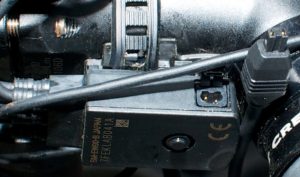
Hacking the SM-BCR2 to have a standard Di2 cable connector: If your 3-port or 5-port junction is inaccessible for charging, there is an alternative hack method to connect it to the system through a standard Di2 port. With basic soldering skills you can hack the BCR2 to be used with any setup. Buy any length EW-SD50 wire, cut off one end. Cut the wire on the output side of the BCR2. Splice the two wires together, so that the output wire of the BCR2 is now a standard Di2 connector. The charger has an inner (white) and outer (shield) wire; connect the inner white wire to the SD50 red wire; connect the charger outer shield wire to the SD50 black wire. You will then be able to plug the BCR2 into any Di2 port. Or use a SM-JC40 junction B and another length of EW-SD50 wire and go through the RD (by using the SM-JC40 to connect the rear derailleur, new output wire of the EW-SD50, and the wire that ordinarily connect the rest of the system to the rear derailleur.) Thanks to @Di2diy for the info.
SM-PCE1: This PC Configuration and Diagnostics adapter will not charge the internal battery. It offers the same configuration options as the SM-BCR2, but also add some advanced diagnostic and troubleshooting features that the SM-BCR2 does not have. It attaches to via the standard E-tube wire (just like the EW-SD50 cables) rather than to a dedicated port on the side of the front A junction.
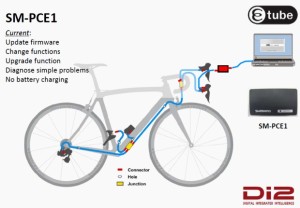
Bluetooth and E-tube Apps for Apple iOS and Android: Bluetooth wireless modules are available to allow system settings to be adjusted via the mobile applications that connect via Bluetooth Adapters.
Component Overview:
The confusing naming system used by Shimano makes it difficult to figure out what each component is, much less what it does and how it fits into an a complete Di2 system. Here’s an overview of all the major Ultegra and Dura-Ace Di2 components.
Dual Control Brake Levers/Shifters (a.k.a. Brifters):
ST-6770 Ultegra Road Dual Control Brake Levers/Shifters: The Ultegra version can be used with the climbing shifters. They are sold in in left/right pairs and are also available separately.
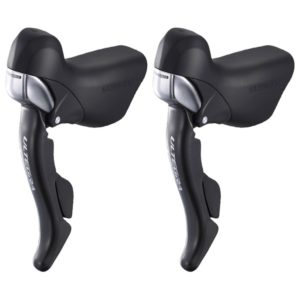
ST-9070 Dura-Ace Road Dual Control Brake Levers/Shifters: The main advantages these have over the ST-6770 version is slightly lighter weight and compatibility with the low-mount sprint shifters. As like the Ultegra version, they are compatible with the climbing shifters. They also have hidden button under the rubber hoods that can activate screen changes on cycling computers from Garmin, Magellan, Pioneer, and Shimano (Shimano SM-EWW01 ANT Wireless Broadcast Module required.)
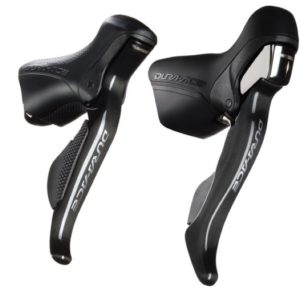
ST-9071 Dura-Ace Time Trial/Triathlon Dual Control Brake Levers/Shifters: These levers provide shifting from the pursuit bar position on time trial bikes. There is no Ultegra option offered at this time. These are available as left/right pairs, or can be ordered separately. These do have a permanently attached wire with a male end for connection the the SM-EW90 front “A” junction. Combined weight both levers: 117 grams.
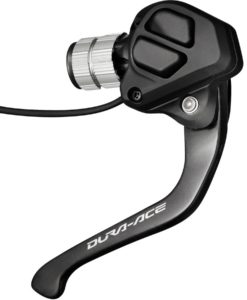
ST-R9160 (standard cable brakes) and ST-R9180 (hydraulic brakes) Time Trial Dual Control Brake Levels/Shifters: These are the lower-profile shifters offered with the newer Dura-Ace R9150 groupset.
ST-6871 Ultegra Time Trial/Triathlon Dual Control Brake Levers/Shifters: Ultegra version of the ST-9071 Dura-Ace shifters. Slightly heavier and much less expensive than the Dura-Ace version. Combined weight both levers: 142 grams.
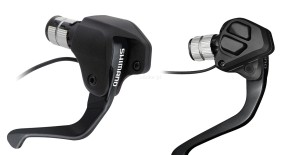
ST-R785 Hydraulic Road Dual Control Brake Levers/Shifters: These hydraulic road shifters are compatible with both the climbing and sprint shifters. These are compatible with the SM-RT99 centerlock 140mm and 160mm rotors and WH-RX31 wheelset (which as no standard rim brake track.) These require the BR-785 dual piston hydraulic disc calipers. They do not have the special wiring port required for the SW-R610 Sprint Shifters and a SM-EW90-B 5-port junction A is required to use the SW-R600 climbing shifter.
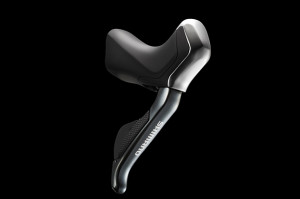
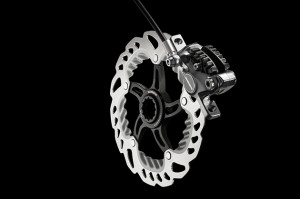
ST-6870 Ultegra Road Dual Control Brake Levers/Shifters: These road shifters are compatible with both the climbing and sprint shifters.
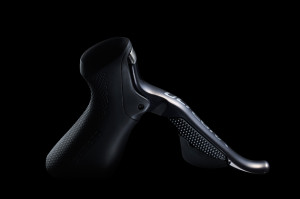
Dedicated Shifters:
SW-R671 Dura-Ace 2-Button Time Trial/Triathlon Bar End Shifters: These shifters are installed on the end of time trial aero bars. By default, the left shifter upshifts/downshifts the front derailleur; the right controls the rear derailleur. For both, the lower button upshifts into a harder gear and the upper button downshifts to an easier gear. This can be changed using the Shimano E-tube Project software; the functions of the left and right sifters can be switched with one another as well. These are available in pairs or separately.
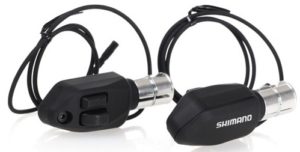
SW-9071 Dura-Ace 1-Button Time Trial/Triathlon Bar End Shifters: These shifters have only one button each and are intended to control only the rear derailleur, with one sending the upshift command and the other the downshift command. (I personally think this version is absolutely worthless. Why have 2 SW-9071 shifters at twice the price and twice the weight, when you can just buy a single SW-R671 Right shifter instead.)
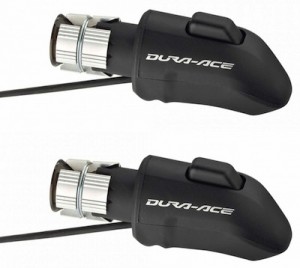
SW-R600 Climbing/PAVE Shifter: This shifter is for road bikes and is mounted on the upper horizontal portion of the handlebar, or any other location comfortable for the rider. They can be used in addition to the Dual Control Brake Lever/Shifter, or can be used on their own by plugging directly into a SM-EW90-A 3-Port Junction or SM-EW90-B Dura-Ace 5-Port Junction.
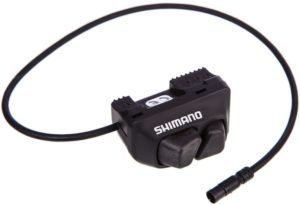
SW-R610 Dura-Ace Sprint Shifter: This is the only component using a unique wiring connector; it is only compatible with the ST-9070 Dura-Ace and Ultegra ST-6870 Road Dual Control Brake Levers/Shifters. Unlike all of the other shifters, the sprint shifters do not contain a circuit board; they do not show up as components on the CAN bus network. Instead, the sprint shifters are simple momentary switches that activate the circuit board on the host Dual Control Brake Lever/Shifter. The host dual control lever is what sends the shift command. (Note: Any momentary switch can be attached to the sprint shifter port on the Dual Control Levers by splicing into a standard EW-SD50 wire to act as remote shifters.)
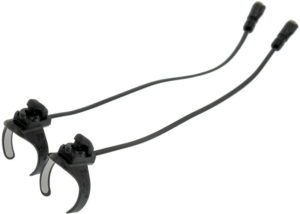
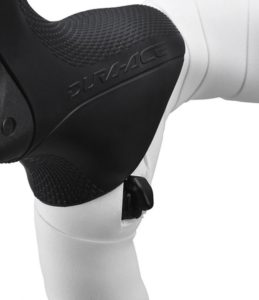
Alfine SW-S705 Right Flat-Bar Shifter: Reported to work with other non-Alfine setups.
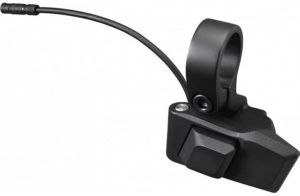
SW-R9160 Time Trial bar-end shifters (pair): These are-end shifters directly control the rear derailleur, with one for the upshfit and one for the downshift. The front derailleur is controlled automatically via automatic Synchronized Shifting. These shifters require the BT-DN110 Internal Battery for synchronized shifting.
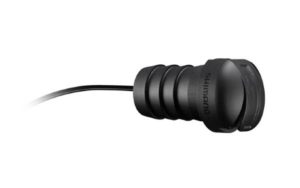
SW-R9150 Climbing shifters (pair): These tiny climbing shifters are about as small as the sprint shifters, but can be directly connected to a junction box and do not have to be connected as slave buttons to a brake/shift lever special port. They come with plastic mounts to make it easier to attach to bars beneath bar tape. They are ideal for synchronized shifting, with one controlling the upshifts and the other downshifts. These shifters require the BT-DN110 Internal Battery for synchronized shifting.
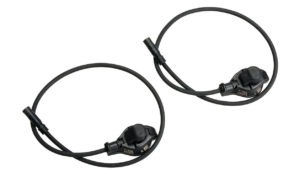

Front Derailleurs:
FD-6770: Ultegra Front Derailleur
FD-6870: Ultegra Front Derailleur, pretty much identical to the FD-6770 but with a slightly larger diameter adjusting screw (to better dissipate the shifting forces).
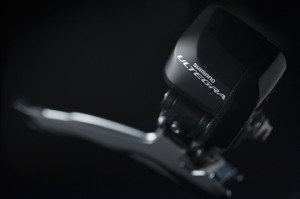
FD-9070: Dura-Ace Front Derailleur
FD-R9150: Dura-Ace Front Derailleur for 9150 systems; features slightly reduced weight vs. 9070.
Rear Derailleurs:
RD-6770: Ultegra 10-Speed Rear Derailleur, compatible with gears up to 28 teeth.
RD-6870: Ultegra 11-Speed Rear Derailleur, compatible with gears up to 32 teeth (for the GS version).
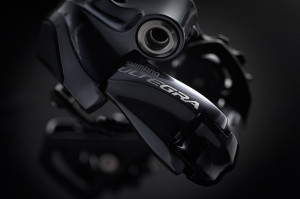
RD-9070: Dura-Ace 11-Speed Rear Derailleur, lighter weight version on which the RD-6870 is based.
RD-R9150: Dura-Ace 11-Speed Rear Derailleur with 30-tooth sprocket compatibility and modified “Shadow RD” geometry to keep the mechanism close to the rear wheel to help avoid damage in the event of an accident.
Alfine SG-S505 and SG-S705: The Shimano series targets comfort and urban bikes. It uses an 8-speed (505) or 11-speed (705) internal epicyclic rear hub. It is believed to be compatible with other Di2 ETube components but this has not been verified.
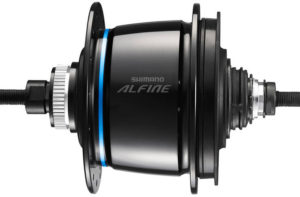
Display / Wireless Communication:
SM-EWW01 ANT Wireless Broadcast Module: This module wirelessly broadcasts Di2 data (front and rear gear selection details, gear ratio, battery life) to a cycling computer using the ANT protocol. It is compatible with Dura-Ace 9070, Ultegra 6870 Di2 and Ultegra 6770 E-tube road shifting systems. SM-EWW01 plugs into the E-tube wiring system between existing components. It has an 2 wiring ports, so it can be connected between a front shifter and the Front Junction A, or at the rear derailleur (between rear derailleur and Etube wire.) It transmits through a proprietary private ANT wireless protocol, which may eventually become a standard public ANT+ protocol. It is powered by the same Di2 system battery. It is currently compatible with the Garmin Edge 1000, Mio 505, and the PRO SCIO cycling computers (with more to come.) The hidden buttons under the hoods of the 9070 shifter levers will switch screens on the cycling computer when paired with this module. It does not currently allow for shifting control from a cycling computer/device and it is not clear that this functionality will ever be offered. The SM-EWW01 is 38mm long, 25mm wide, 12.5mm high, and weighs less than 5 grams. It does not come with any wires; 1 wire would have to be added if adding this module to an existing Di2 system.
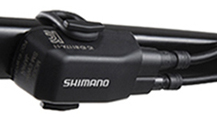
EW-WU101 and EW-WU111 ANT and Bluetooth Wireless Broadcast Modules: These modules are similar to the SM-WEE01 but also include Bluetooth capabilities in addition to ANT capabilities. They require the BT-DN110 battery or the BM-DN100 Battery Mount and cannot be used with the SM-EW67 Front A Junction.
SC705 Alfine Display Unit: This unit displays the battery level and the rear derailleur gear selection. It is powered by the system battery and has a port for the SM-BCR2 internal battery charger / USB diagnostic tool. It is primarily designed for Alfine systems (both 8 505-series and 11 speed 705-series). It is compatible with Ultegra and Dura-Ace Di2.
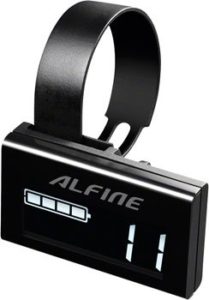
MT800 Digital Display with Bluetooth: Primarily aimed at XT mountain bike applications, this display allows toggling between the 3 synchronized shift modes (where both derailleurs are intelligently coordinated in unison by one pair of buttons, so no need for discrete shifting of the front derailleur.) It also shows battery level, gear position, shift mode and FOX iRD suspension position. The Digital Display required the new BT-DN110 battery. Existing Di2 XT systems are upgradable to be compatible with the new digital display after battery upgrade and firmware upgrade. This display has 3-port Di2 Cable junction and charging port integrated into the back and serves as a Front A Junction.
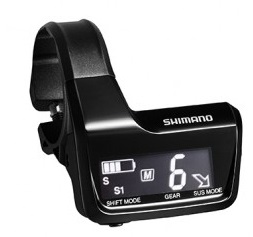
Batteries and Battery Mounts:
The batteries contain the main controllers for the system. It is therefore required to upgrade the battery to get features released in new versions of Di2 (such as Synchronized Shifting that automatically controls the front derailleur based on rear derailleur shifting.)
SM-BTR1 External Battery: This external battery must be used with the SM-BMR1 battery mount. It is removed from the mount and charged using a dedicated charger.
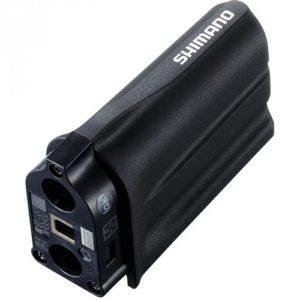
SM-BMR1 and SM-BMR2 External Battery Mount: This mount attached to bottle cage mount points or other dedicated frame mounts. It is available in 3 different mount lengths: -I (intermediate length), -S (short length), -L (long length). The SM-BMR2 is an updated version of the SM-BMR1.
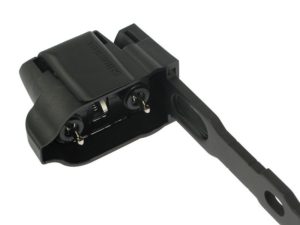
SM-BTR2 Internal Battery: This battery is typically mounted in the seat post or seat tube of the frame. It is charged by plugging the SM-BCR2 Charging Cable/PC Adapter into the SM-EW90-A or SM-EW90-B Front A junctions.
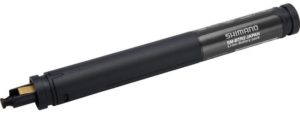
BT-DN110 Internal Battery: This battery is required for Bluetooth wireless units and road groupset Synchronized Shifting functionality.
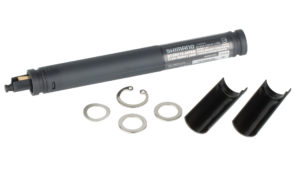
BM-DN100 External Battery Mount: This battery is required for Bluetooth wireless units and road groupset Synchronized Shifting functionality.
Front A Junctions:
SM-EW67-A-E Ultegra 3-Cable Junction: This is the original front junction with 2 integrated cables to connect to the dual control brake lever/shifters. The male cable ends on this Front A Junction will not mate directly to the male cable ends on any of the Time Trial/Triathlon dual control brake shift levers or shifters; SM-JC41 Rear B Junctions can be used to connect this front A junction to TT/Triathlon shifters. This Junction works only with External Batteries, not Internal Batteries.
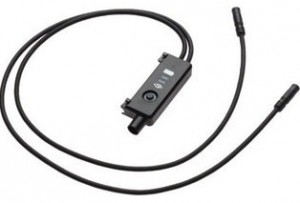
SM-EW90-A Dura-Ace 3-Port Junction: This front “A” junction is most commonly used in road bike setups. 2 ports connect to the dual control brake / shift levers; the third port is for the cable that leads to the bottom bracket junction.
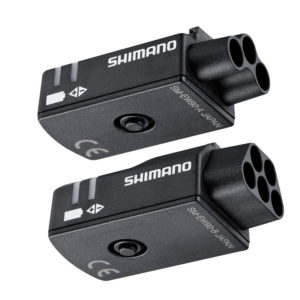

SM-EW90-B Dura-Ace 5-Port Junction: This front “A” junction is primarily used in the Time Trial / Triathlon setups. 2 of the port are for the brake/shifter dual control levers, 2 of the ports are for the aer0 bar bar-end shifters, and the 5th port is for the cable that runs to the bottom bracket (where the B junction joins the wires from the front A junction, front derailleur, rear derailleur, and battery.)
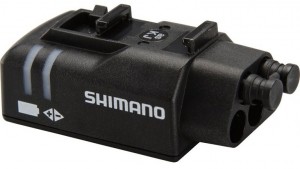
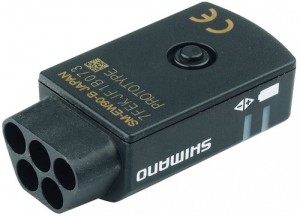
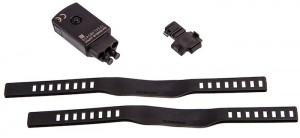
EW-RS910 Internal Bar-end Junction: This junction is installed into the end of a bar or in a dedicated frame port. It facilitates internal cable routing.
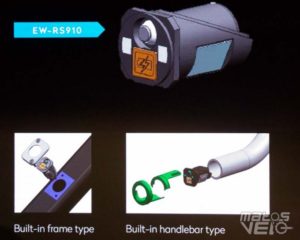
B Junctions:
SM-JC41 Internal Junction: This version has the exact functionality as the SM-JC40 external version, but doesn’t have the mounting tab for being bolted to the bottom bracket or wrapping the extra cable lengths. It has 2 ports on one end and 2 on the other, making it more compact. In addition to being located at the bottom bracket to connect the A junction, battery, front derailleur, and rear derailleur, it can be used at the handle bars to join multiple shifters prior to being connected to the A Junction.
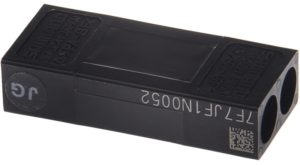
SM-JC40 External Junction: This version is intended to be attached to the frame using the bolt that is commonly located underneath the bottom bracket housing. This junction contains no electronics; it’s sole purpose is to join 4 connectors together, which are usually the wire from the front A junction, the battery, the front derailleur, and the rear derailleur. There are wire holders above the housing to capture the extra wire length by wrapping it back-and-forth.
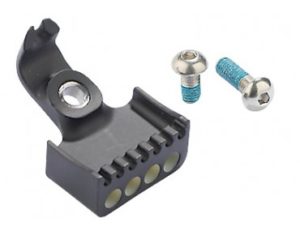
Cables, Grommets, and Cable Remove/Install Tool:
EW-SD50 Cables: These cables connect the front A junction, the battery, the front derailleur, and the rear derailleur to the rear B junction, which is typically located near the bottom bracket (near the cranks.) These are available in lengths of 300mm, 350mm, 400mm, 500mm, 550mm, 600mm, 700mm, 750mm, 950mm, 1000mm, 1200mm, 1400mm.
SM-GM01 Grommet: These round grommets are used when drilling round holes for internal cable routing, or with existing round holes. The required hole diameter is 6mm (6mm = .236 inches. Use a 7/32-inch drill bit and then “wallow-out” the hole to make it a little bigger; a 1/4-inch drill bit will work but is just slightly larger than necessary.)
SM-GM02 Grommet: These 7mm x 8mm oval shape grommets are used in some situations / frame designs.
Shimano TL-EW02 Ultegra DI2 E-Tube Tool: This tool is used to connect and disconnect the Etube wires. They are extremely difficult to connect/disconnect by hand, and pliers or other tools can damage the wires. Don’t get this confused with the TL-EW01 tool, which is for the older 5-wire 7970 cables. (My Dura-Ace TT Dual Control Levers came with one of these tools, but no other components did.)
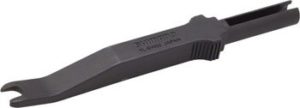
Common Questions (via Shimano):
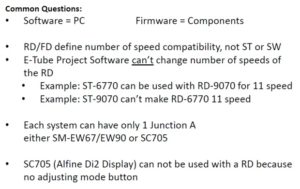
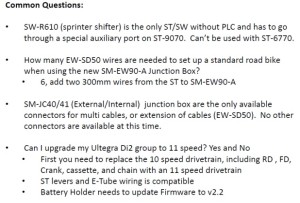
Note: it is not necessary to replace the FD from upgrading from 10-speed to 11-speed.
What Components do I need to put together my own Di2 system?
Because of the huge number and variety of components, it’s very difficult to figure out what is actually necessary and what is optional. So here is a list, for the setup I recommend: Ultegra 6870. It starts from the handlebars and works backwards. (This assumes both front and rear derailleurs, but you actually don’t have to have both; you can pick one or the other and only the corresponding front shifter to go along with it.)
- Any Type of Shifters / Shift Buttons. The Dual Control Brake Levers/Shifters are not required. You can get the just the climbing shifters or Triathlon/TT bar-end shifters, and then potentially add the Dual Control Levers/Shifters at a later point. (The only exception is the Sprint shifters, which require specific Dual Control Levers/Shifters with special ports as noted elsewhere in this article.) Amazon.com link
- EW-SD50 Wires 1 and 2 between the front shifters and the Front Junction A (0nly for some shifters). This is a bit confusing, because some of the front shifters come with wiring attached to them and some of them require purchasing separate wires. In general, most of the stand-alone shifters come with wiring, as do the TT/Triathlon dual control shifters/levers, but the road dual control levers do not. Amazon.com link
- Front Junction A. I recommend the SM-EW90-B 5-port front junction A as it provides the most upgrade flexibility; get the 3-port option only if you’re positive you’re never going to add more shifting components. The older SM-EW67-A-E has 2 wires built-in to connect with each of the dual control shift/brake levers; it doesn’t offer much flexibility or compatibility with a TT/Triathlon setup or adding additional shifters. Amazon.com link
- EW-SD50 Wire 3 between the Front Junction A and the 4-port Rear Junction B connector. Amazon.com link
- EW-SD50 Wire 4 between the Rear Junction B and the Front Derailleur. Amazon.com link
- EW-SD50 Wire 5 between the Rear Junction B and the Battery. Amazon.com link
- EW-SD50 Wire 6 between the Rear Junction B and the Rear Derailleur. Amazon.com link
- Rear Junction B: This is where the wire from the front of the bike is connected to 3 output wires leading to the front derailleur, rear derailleur, and battery. SM-JC40 is for external wiring, SM-JC41 is for internal. Amazon.com link
- Grommets for any place where the wire goes into the frame through a drilled hole. Amazon.com link
- Front Derailleur. I recommend the Ultegra FD-6870 for 11-speed builds or the FD-6770 for 10-speed builds. The Dura-Ace FD-9070 is pretty much identical, just slightly (41g) lighter and 11-speed only. (I do not recommend the Ultegra FD-6770 unless you have a 10-speed setup, because of firmware compatibility issues with 11-speed rear derailleurs. Also, it is an older design than the FD-6870, so it is larger and offers slightly less shifting force.) Amazon.com link
- Battery and Charger. Internal or external, depending on the build. If you have to skill/time/money-to-pay-someone to get everything internal, I highly recommend that option. The SM-BTR2 internal battery has more advanced integrated electronics and is better for firmware upgrades with the SM-BCR2 internal battery charger/PC tool. If you go with the SM-BTR1 external battery, you will need the SM-BMR1 external battery mount and SM-BCR1 external battery charger. Amazon.com link
- Rear Derailleur. I recommend the Ultegra RD-6870 for a new build if you have 11-speed compatible wheels with 11-speed sprockets, or the Ultegra RD-6770 if you have 10-speed wheels/sprockets. The system must be match front and rear derailleurs (both 6870 11-speed or both 6770 10-speed.) Amazon.com link
- TL-EW02 Etube Wire Remove/Install Tool: It takes quite a bit of force to snap the wires in/out. You may think you can get it seated properly with just your fingers, only to then have the wire come loose because it wasn’t fully seated. It’s a good idea to keep one in your saddle bag. Amazon.com link
What wire lengths do I need? This question is impossible to answer correctly, as it’s highly dependent on the frame size and configuration. What I recommend is running string between the component mounting locations to measure the lengths. Be sure to add some extra length, as I find that wires seem to come up short pretty frequently, even when “adding a little extra” to start with. Nothing is more frustrating that having a wire that is 25mm too short. I recommend ordering a few extra wires of multiple lengths and then returning the unneeded/unused wires. As noted above, the standard wire lengths are 300mm, 350mm, 400mm, 500mm, 550mm, 600mm, 700mm, 750mm, 950mm, 1000mm, 1200mm, 1400mm. Do not cut/splice these wires; the connectors on the end of the wires are very small in diameter to start with and you’ll end up with a splice that is larger and less waterproof than you started with.
Acknowledgements: Special thanks to Di2diy for his continued help in the comments. Check out his Ebay store for custom Di2 batteries, harnesses, and components.
Technical Details of the Di2 CANBUS protocol and signaling
Thanks to commenter Ghislain for the details: “I reversed engineered the signal going to the RD. Since I did not have a special tap connector, I could only look at the actual signals in open loop (RD wire disconnected) on the wire going to the RD using an oscilloscope. First, I found that shift up and down are multiplexed on the same wire. A shift down would generate a positive 100 msec clean 8 volt pulse (varies between 50 msec to 500 msec depending on how long you hold the shifter). On the same wire, a shift up would generate a series of 2 msec pulses that would last the same time of a shift down pulse. Therefore, the RD has enough intelligence to discriminate between the 2 types of pulses. When you hold the button on junction A, a 140 msec pulse is generated. But since my RD wire was disconnected, the RD would not go in adjust mode.”
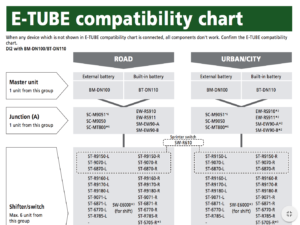
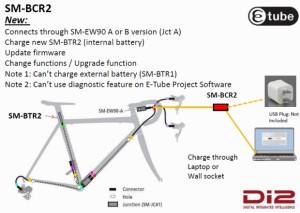
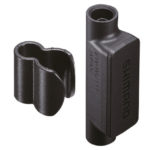
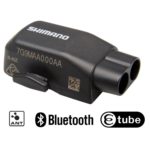
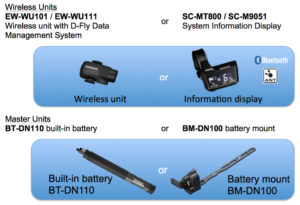
Hello
Is it possible to run 11 speed with internal battery, EW90, RD6870 and FD6770
Kim
No, both your deraillers need to be 6870
Great site – new to Di2 and have 6770 setup but want to add hydraulic discs.
Have purchased ST-R785 levers, but when connected do not operate either of the derailleurs.
AFAIK the original 6770 has never been updated, any ideas what the problem may be?
As it says in the article, make sure all of your firmware is updated to the latest version when adding new components.
Hi can you advise on my di2 system. It doesn’t look like the 5 pins old generation . It has 4 pins in the rear d and 4 holes on the cable end
Your Dura Ace 7970 system has connections with 4 pins going to the FD & RD, 5 pins going to the junction up front.
Hello Carlton. Thanks for all those precious informations. I got now all necessary parts to convert my bike to Ultegra di2.
Nevertheless, I got a question regarding cables length. In the dealer manual, there is informations about maximal length. For exemple, it is said to not go beyond 1500mm when adding a+c, where a is the cable length between the battery (DN110 for me) and the B junction and c is the FD to B junction length.
What’s happen if those length limits are not & using greater total length ? Does it matters really ?
Thanks for your help.
Regards from Marseille, in Provence, south-est of France
In my experience, if you go a bit longer than that, there is no issue. Longer cables barely add any additional resistance, well within the design margins.
Can you reprogram 7970 10 speed levers to work with a 9070 rear and front mech
This question will s very clearly answered in the article. No.
Hi Carlton
Hope you’re well When ichecking battery life on dura ace 9070
Di2 both green and red lighs light up
Why is that
Please assist
Reg Martin
Hi, looking at the comments it appears that the conversation is about Di2 road equipment but my question is about MTB but I hope you will indulge me. I purchased a RD-M9050, SW-M9050, SC-M9050, SM-JC41 and assorted EW-SD50 cables to connect them according to the manual. I have a SM-BMR1 battery mount and SM-BTR1 battery. After connecting the components there is no shifting. Double checked the connections and tried again and still nothing. Having read some of the comments it appears that the SC-M9050 may not work with the SM-BMR1 battery mount. So, I switched to a SM-EW67A hoping to eliminate using the SC-M9050. The LED on the SM-EW67A goes green for a few seconds but still no shifting. Is there something else that I need to check or something I’m missing? I have a Fox iCD suspension installed and it works fine with the battery system and cables. Any help would be greatly appreciated. Thanks
Hi, can you please confirm the exact name of the front and rear derailleur for the Dura- Ace9070 version?
I thought they were FD-9070 and RD-9070 but, instead, you call them FD-9770 and RD-9770.
Just want to make sure that was a typo and not different version/models.
Thanks
Andrea, thanks for catching the typo. 9070 is correct.
I just installed Di2 on my bike.
BT-DN110-1 battery, ST-6870 brakes, FD and RD 6870 derailleurs, SM-JC41 4 port distribution, SM-EW90-B 5 port front hub, SM-BCR2 charger.
Don’t have EW-WU101 yet.
System works ok except the battery died twice after a day with a full charge.
System isn’t accessible through app until WU101 shows up. The PC app shows all pieces “green” but won’t load.
Ideas?
Thanks
Can I run a 11/32 cassette on dura ace di2 if I change the rear derailure to Ultgrea 6870 di2 with a medium cage.
I currently run dura ace di2 on a compact 50/34 with a 12/28 cassette
Please advise.
Thankyou
Yes you can.
The other possibility is it may work with your 9070. It depends on droput design and you’d probly have to back off the B-tension scew all the way and make sure you use enough chain length or avoid the big big combo. My frame builder told me it would work on my bike and it did. Same 50/34 front 11/32 rear Di2.
Hi, is it possible to run wireless unit EW-WU101 with the internal battery SM-BTR2?
Ian, please read the section above: “EW-WU101 and EW-WU111 ANT and Bluetooth Wireless Broadcast Modules”
Hello –
Wonderful site and information.
My wife and I have two bikes with Di2 installed. We’d like to be able to get them to connect with our Garmin Edge 1000 and also to be able to program synchronous shifting (if we can without replacing everything. Everything is currently working great, we’d just like the added features and functions. (ANT communications with Garmin and BT with iPad).
One is configured with a flat bar and XTR shifters. Here’s the rundown:
FD-6870 Front
RD-6870GS – Rear Long cage
SB-XTR-SW-M9050 Left
SB-XTR-SW-M9050 Right
SC-M9050 Display Unit (Junction box and charging port)
SM-BTR2 Internal Battery
Misc cables to put it together.
Can we simply swap out the SC-M9050 with a SC-MT800?
Second configuration is a drop bar road bike with all Ultegra and the added SC-M9050 display. Here’s the list:
FD-6870 Front
RD-6870GS – Rear Long cage
ST-R785R Right Shift/Brake 11SP Hydraulic
ST-R785L Left Shift/Brake 11SP Hydraulic
SC-M9050 Display Unit (Junction box and charging port)
SM-BTR2 Internal Battery
Misc cables to put it together.
Same question – can we simply swap the SC-M9050 for the SC-MT800 to get the extra functions?
Thanks for your help.
Kevin: refer to the compatibility section. You’ll need to upgrade the battery and the Bluetooth transmitter.
Hi,
I am about to replace my Ultegra mechanical drive train to Ultegra Di2 for my road bike:
here are my components:
1) FD-6870
2) RD-6870
3) ST-6870 shifters
4) BT-DN110 internal battery
5) JC-41 internal Junction B
6) SM-MT800 junction A
7) Required amount of Di2 wire and gronets
I am intending to use the MT-800 display as junction A instead of the SM-EW90-A.
The display will look more elegant and will give the status of the internal battery, I prefer this to the Sm-W90-A. Besides it will also communicate with my Garmin 810 through private ANT, I am told.
Will the above configuration work and is there anything else that I need?
Thanks and regards,
Keyshore
I haven’t tried this exact setup, but it should work. Just be sure to install the latest firmware on all components for cross-compatibility.
Hi Guys,
I’m collecting bits to build up a winter/gravel bike in the Spring. Basically planning on a drop barred bike with MTB (clutch) derailleurs. I’ve mistakenly (stupidly) bought a second hand XTR Di2 groupset that included a triple front mech (didn’t even cross my mind, i didn’t think they made them anymore!). Firstly, does anyone know if you can programme, or maybe using the limit screws to effectively make it a double? (I know i’m clutching at straws here!).
Also, if I need to buy another front mech, does the XT front mech work ok with an XTR rear? I assume it does, but havent really heard of anyone mixing 6870 with 9070 on the road side either.
As always, a great Di2 resource.
Thanks in advance
I have a cycle fitted with Di2 9070 series and would like upgrade to full SHIMANO Synchronized Shift system, could tell me what items I need to do the upgrade
New Battery and firmware. Details in the post above.
I have a 2013 Giant Defy with Ultegra Di2 (6770 group) with external battery mount. I called Shimano because I wanted to add Bluetooth capability. My goal was to set things up so I could use the new IPAD app. to diagnose and tune the system. I bought the EW-WU101 and the BM-DN100 but then read that the SM-EW67A front wiring unit (the one I have) might not be compatible with those two units. You say that those two parts cannot be used with the SM-EW67 Front A Junction. Shimano says the SM-EW67 Front A Junction is compatible with the two wireless units and will work. I have called them twice and each time they say the same thing. If you would, can you tell me why you say it will not work? Has that been your experience? Also, might the software have been updated to allow all three units to work together? Thank you in advance for your help. jimg
Hi James,
Have you considered replacing the front junction with the SC-MT800 display? This has three ports that can replace the junction, has a port for charging the system and provides the bluetooth and Ant communications capabilities.
Jim, Shimano engineers provided the info at the product introduction event saying that the SM-EW67A would not work. But this is Shimano we’re talking about, who are notorious for confusing and conflicting information. So does it “kinda” not work (i.e. no way to charge the battery)…or “completely” not work (no shifting)? It’s hard to say until you try it and find out. And it’s not at all surprising to get different answers from different Shimano employees. Please let us know what you find.
So at first I thought I would blow off the wireless conversion effort because of the cost> Now I am re-thinking things and was wondering, if I buy the SM-EW90a front junction box and use it in conjunction with the other with EW-WU101 and the BM-DN100, do you think the system will work then?
What is your current BM-DN100 firmware?
Can you update BM-DN100 firmware it to latest 4.0.4 via iPad or PC ?
Hi Carlton,
I am building a R9150 setup and am looking for information about the EW-WU111 Comms Module. Does it matter where it goes in the system, obviously better to know prior to purchasing the cables so I can get the correct lengths?
Thanks in advance for any reply.
John
It doesn’t matter where it goes. Any place in the system is fine. I have mine in the seat post tube with the internal battery.
Thanks for the reply, yeah the seatpost tube is my favoured option too as if I put it next to the battery I can get access to it should I need to without removing the bottom bracket
Hi. Does anyone know if there is an incompatibility problem between Shimano Alfine Di2 and the external battery SM-BTR1? Because I just bought an external battery and support and it does not work! But works properly with the internal battery SM-BTR2.
Do I have to update the new battery?
In order to add synchro shift capability to a 6870 system with an external battery, is it just the *mount* that has to be upgraded to the BM-DN100, the *battery* itself or both? The article seems to indicate that it’s just the mount, but a lot of the comments refer to needing a new battery so I’m not clear as to which piece carries the upgraded components.
The battery mount hast the firmware battery is just power.
SM-BMR1 – this mount can only be updated via SM-PCE1.
SM-BMR2 – is it possible update this mount using SM-BCR2 ?
BM-DN100 – is it possible update this mount using SM-BCR2 (or bluetooth)?
also there is this comment that contradicts FAQ info:
Di2diy
2016-September-26 at 4:37 am
“I want to update this reply:… I think you misunderstood about the BCR2 NOT being able to update the external mounts (BMR1&BMR2) they can both be updated using the BCR2, it is not necessary to us a PCE1, although you could use both. I just updated a BMR1 to 3.0.10 using the BCR2, no problem whatsoever. you cannot charge through the external mounts but you can do all the updated.”
I think your misunderstand is in the context of the thread, The question was in regards to a hacked BCR2 being used to update the mounts… its cant be done with a hacked BCR2 because of the EW67 in the system, it can be done if an EW90 in being used. Or perhaps its not clear to me what you are trying to say (?)
James Grant
2016-December-09 at 12:42 pm
So I installed the SM-EW90a junction box along with the BM-DN-100 and the and the EW-WU101. But I can’t get the Bluetooth to pair with the junction box. The rest of my setup is 6770 Di2. I press the button on the bottom of the junction box like they say (for a second or so) and I get no indicator light signal at all. The system shifts fine and the Di2 information shows on my Garmin, but I can’t update firmware because the system won’t pair with my IPAD. Any ideas?
You most likely need to update the firmware using a PC and cable first. The junction probably doesn’t contain firmware that is compatible with the Bluetooth module. Subsequent firmware update could be done over Bluetooth, but not the initial compatibility update.
hello i have one groupe ultegra DI2 6770 with jonction SM EW 67 A
can you tell me if i can upgrade my groupe on 6870 DI2 11 speed with SM EW 67 jonction and FD RD 6870 derailleurs only with upgrade etube ?
thanks
Yes, that should work.
Synchronized shifting for road di2 is released. Does somebody try it ? How to choose between map 1 & map 2 on the bike ? Mine is 6870 Ultegra di2 with DN-110 battery & the bluetooth adapter. All firmware up to date but no PC at home to test for the moment.
I have the same setup you do and did all the Dec 9 updates. The PC E-tube program still says I need to update the FD/RD also, but no updates are available. I hear people with 9070 say the same. So it seems that synchro shifting is not quite ready yet.
Thanks for the update. That’s disappointing. I have the upgrade components ready to install but haven’t installed them yet.
Confirmed. Mine also says “the settings cannot be read from the following unit(s) because the firmware is not the latest version”. Update the firmware…FD-9070/RD-9070…
Hi, I’m using Dura Ace 9070 and lately have problem with Junction A Led. The green and red led will light whenever I long press the shifter button and after checking battery status by pressing 2 shifter buttons.
What’s the problem? Thanks.
I have a Specialized Roubaix with (firmware level):
Shimano Di2 SM-BMR2 Battery Mount SM-BMR2 (3.0.10)
Shimano E-Tube Di2 Cockpit Junction Box SM-EW90-A (3.0.4)
Shimano Ultegra FD-6870 Di2 Road bike Derailleur FD-6870 (2.6.2)
Shimano Ultegra RD-6870-GS Di2 2x11s 28-32 RD-6870-GS (2.6.3)
Shimano ST-R785 Di2 Hydraulic STI Lever, Left ST-R785-L (3.0.0)
Shimano ST-R785 Di2 Hydraulic STI Lever, Right ST-R785-R (3.0.0)
Shimano Di2 D-Fly Wireless Transmitter SM-EWW01 (3.0.6)
To get Synchro Shift:
What will I need besides upgrading the External Battery Mount with BM-DN100?
Will the Wireless Transmitter SM-EWW01 be superfluous?
Hi I recently bought a Di2 Ultegra 6870 Bike. It has only the STI levers and no SPrinter or TT switches.
I updated the Firmware to the latest version: [email protected], [email protected], [email protected]; [email protected], [email protected]
When I try to load the presets on the bike by read presets from the bike, I get an error:
Error occurred while reading he settings.
Also when I try to set up Synchronized shifting, I get error message: “The settings cannot be read because the firmware is not the latest version. Update the firmware of the units to be read. FD-6870 and RD 6870-SS”
But I have just updated the latest firmware.
The firmware for the FD amd RD synchro shift is not out yet even if you have the new battery or new battery holder which is also required even though Etube seems to be ready to configure it.
Thanks.. The automatic setting up of Synchroshift fails with the said message. But I can set up a preset manually into a file with the Syncroshift options and save it to my desktop. I did not want to write the preset .ini file to the bike. I was not sure if it would go thru.
Do u think writing the preset (.ini) file with symchroshift information might mess up the system.
Not sure? Interesting thought and I’m no expert on that approach. But it might be risky if something in the firmware is also required for good synchro shift. That said, people have written hacked synchro shift stuff for Road Di2. I’m hoping the read deal comes out soon.
Ken S writes that people have written hacked synchro shift stuff for road Di2. Can he point us to a link? I want to have the front shift buttons also shift the rear. I do not want what XTR synchro shift does which is have the rear shift buttons shift the front when the computer thinks it knows better than the rider.
Also, the Shift Mode button is available via the SHimano MTB component: “XTR DI2 SC-M9050 DIGITAL DISPLAY UNIT”. But on a Ultegra 6870 Di2 system, I am not sure how you can switch between the 2 shift modes. or for that matter even cancel out of Syncro Shift mode to manual.
Otherwise, if the system runs out of battery and Front Derailleur shifting is not happening, you are stuck.
Perhaps, I am guessing the shift mode may have to be controlled via a ANT/Bluetooth interface like a Garmin 520.
Any thoughts…
Thanks Carlton et al for all of this.
Is there a way to search the comments on this website?
Can a sprinter switch on the rear shifter be set to shift to larger rear cogs, instead of the normal sprint goal of smaller rear cogs?
Are there any known issues of upgrading software to the latest version on 1 or 2 year old 9070/6870 seatpost battery setups? I hate to upgrade and then see things not work; yes I am in the computer industry and this does happen.
Is there a description somewhere of how road synchro shift is intended to work when it comes out? i.e. will it shift the rear when I shift the front? Or will it be like XTR and shift the front when I hit the rear shifter and the rear derailleur is near the limit? I want the former, not the latter. I have ideas on how to accomplish this with a PIC but I would prefer to ride the bike than go through the design and experimentation.
Does anyone know of a similar site for Campy EPS?
And does anyone know of Campy EPS shifters hacked for 9070 di2? Yes I can imagine how to do it, but reading about it would help.
Not sure I should post the links on references to hacking Di2 for road synchro shift. Check fairwheel bikes and Arts cyclery for a start but I cant find the referenced road test I had remembered. Most all synchro shift hacks involved using XTR front der but I though I remembered one that didnt. Don’t know how it will work but hopefully its customizable for preference and hopefully its not vapor ware. It’s late in releasing.
I have updated the previous internal battery version with no issues. E-tube knows which model you have and should load the right firmware….
After riding Campy for decades I reluctantly went to Shimano when I decided to go to eshifting due to a left arm/hand issue. Would have liked to have stuck with Campy for looks but Di2 just seemed more refined overall and liked the cabling better and it seemed more likely that Shimano would come out with Synchro.
The only synchro hack I have seen is the fairwheelbikes pre-eTube one where they built their own control module and programmed it themselves.
I have not seen anything on Art’s cyclery, but my search techniques are not great.
The XTR front is not easy to mount on a road bike with road chainring positions. One person did it on a Calfee tandem by modifying the mount.
http://bike.shimano.com/content/sac-bike/en/home/news-and-info/news/shimano-introduces-new-dura-ace-r9100-road-components–integrate.html
“In addition to traditional “Full” Synchro Shift, riders can optionally select “Semi” Synchro Shift. This intuitive new mode automatically reacts when the rider shifts from one chainring to another, automatically shifting the rear derailleur to minimize the gear step, thus preserving the rider’s rhythm.”
That’s what Shimano is saying. If and when it will happen remains to be seen.
I have suffered 2 SM-BMR2 unit failures. It looks like corrosion at the point where the e-wire connects. Is it possible to clean the terminal and avoid replacing the unit?
I have an Ultra di2 setup with SM-BTR2 battery, SM-EW90-A junction, and 6870 shifter components. I charged the battery and updated to the latest firmware. The only firmware change was to update the SM-EW90-A junction to 3.0.4.
Now, when I check the battery charge, the charge light goes solid green as it should, but then it momentarily goes off and comes back on simultaneously with the red trim light for a few seconds, then they both go out.
The shifters seem to operate normally, and no lights come on when shifting.
Has anyone seen the lights behave like this and have a fix?
Also, not sure if it’s related, but when I try to customize the shift mode setting, I get an error that says: Settings cannot be read from the following units because the firmware is not the current version. Update the firmware of the units to be read. FD-6870, RD-6870-GS. However, the firmware is already updated.
Any suggestions?
You’ll need to wait until newer firmware is released. The current version isn’t fully compatible with the newer components.
I guess they messed up by allowing the newer component to update with incompatible firmware.
Do you know if the components will still operate properly? If not, is there a way to revert back to the previous firmware?
Everything should still operate normally but you won’t get new features. Instructions for reverting to previous versions of firmware are in the post above but I don’t recommend it.
hello
Exactly the same thing since updating SM-EW90-A. Green and red after… RD-9700 and FD-9700 are waiting for a new firmware update !!
I have also the same eroor message.
But all is working fine !!
Hello,
I have a question?
How can i extend the new dura ace di2 rd – r9150 11 speed (maximum cassette = 11-30) with a larger cassette 11-32 or 11-36 or even 11-40?
Sorry for my English.
Greetz
Jean-Paul Milissen
Wolf Tooth Components makes a device that lowers the rear derailleur on the frame.specifically for their large rear cogs. I have not tried it. The shifting at the small rear cog probably suffers.
I know the pro teams either use a long cage Ultegra cage
I think an 11-40 is going over the top but try Fit Werx in Vermont, ‘http://fitwerx.com/index.php?s=K-Edge’, for options on the long cage derailleur conversion. Haven’t needed them myself but believe they could help you. Good luck.
Hello Jean
I have 2 bikes, both with 6870 Ultegra and both running a 32-11 cassette. On one bike I have the long cage and on the other I have the short cage. I cannot fell any noticeable difference in shifting long or short cage – Many have done the same also with good results and my best guess is that you could go at least to a 36-11 with a 6870 long cage version.
Shimano 6870 SS Short Cage version is compatible with a 28T Cog,
Shimano 6870 GS Long Cage version is compatible with a 32T Cog.
You must have two long cage derailleurs.
I’ve used my ten speed Ultegra 6770 Di2 with a 32T cog. It works fine. I borrowed my girlfriends wheel once in the Pyrenees forgetting that it had a bigger cassette.
Not sure if it would affect the longevity, but it works.
Sorry but I do know exactly what I have and Google is your friend, do a search with “6870 short cage + 32-11” and you will find that many many other bikers have done the same with very good results. Shimano is very conservative with their specifications and I’m indeed running a 6870 short cage together with a 32-11 cassette with good shifting. Sometimes you will have to install a longer bolt for adjusting the RD a bit further away from the biggest cog but that was not even needed in my case.
I have a similar set up but with Ultegra 10 speed. I changed the RD cage from short to an XT medium but reused the RD and changed the largest cassette cog to Wolf 40 on a Deore XT 11-36. Also removed the 11 cog and substituted an Absolute Black lock ring. I added a Wolf Tooth components “Road Link” to get clearance between the large cog and the jockey wheel. Works fine in my system.
Using 11 speed you have an additional problem of finding a road specific cassette with 32, 40, or 42 cogs. The spacing on the 11 speed road and mountain cassettes are not the same.
According to Leonard Zinn the 11 speed mountain and 11 speed road are the same. Near the bottom of this linked page:
http://www.velonews.com/2015/04/bikes-and-tech/technical-faq/technical-faq-chainring-and-cog-compatibility_368165
Also in my bench experiment 11 speed xtr di2 did work with 11 speed road cassettes.
Hi, thank you for the very good information about the DI2 system.
I´m running a 6770 setup. Is it correct, that if I change to the BM-DN100 I can use synchro shift?
Thank you for your help
Theoretically, that is correct. But Shinano has not yet released firmware to make it work. So we won’t know for certain until they do.
I don’t see this answered above but perhaps you can answer it directly. I want to put together a 11 speed di2 system with a large cassette range. This will go on a Domane SL frame
I am leaning right now to having di2 xt components for the RD, braze on FD, front display/junction A, B internal junction. Battery will likely be internal but according to the Trek dealer an external battery and mount, mounted internally in the down tube can be used. Brifters would be Ultegra 6870. Cassette will be xt. Crank will be Ultegra compact. Cassette will be 11-40 or 42 xt.
The frame comes with a braze on FD mount. Will this be compatible with a braze on FD ie are the offsets the same comparing road and mtn? I know the arc of the cage will be different but I can overcome this.
I will likely have to add a Wolf Tooth Road Link.
Which battery and mount would you recommend?
Jack, this is a very complicated setup, beyond the typical amounts of variation. I’m not sure about the front derailleur; a road version would be much more likely to be compatible. Definitely go with an internal battery due to easier recharging.
The XTR front derailleur expects to use mountain chainring spacing from the frame. One person has used an XTR triple front derailleur on a Calfee tandem and a Lightning triple crank with road triple chainrings. That involved custom machining of the Problem Solvers front derailleur mount to move the derailleur closer to the frame. My guess is the XTR double front derailleur will be very hard to mount on a Domane frame and shift a road crankset. It will be hard to mount to a road braze-on unless someone has made a mount that I have not seen yet.
http://www.bikeforums.net/tandem-cycling/1006217-2015-calfee-dragonfly-build-4.html
Modifying the road rear derailleur and dropout for wide range is probably easier than modifying the mountain front derailleur. I would be happy to read about successful front derailleur hacks and modifications.
Are there any considerations for internally routed Di2 on a travel bike with S&S couplers? Is it as easy as positioning the B junction box at the downtube coupling point and providing 20cm or so of slack in the downtube wires?
You got it. It is that easy. Junction box just making sure you have enough cable for reach and ease.
Is my SM-EW67A, SM-BMR2 compatible with the EW-WU101 I just bought? Nothing operates since I put on the D-Fly
Make sure all your firmware is updated. I use the same equipement and all works fine.
Hi, I am sorry I made a mistake. I use an EW90 B 5 port junction. So now I am not sure your setup will work after a firmware updat. Sorry for my mistake.
Sorry if this question has already been answered but if the junction box A is inside the frame, how does one check the battery level easily and then charge the internal battery easily
Easy? Depends on where it is in the frame. You will need to see the junction box to check the battery level, an to charge through it. You can modify the charger by splicing a connector to the input of the charger. Just buy any length cable, cut it and splice it to the charger, than buy a JC41 junction box, than you can charge through the RD cable, by plugging the spliced cable from the charger and the RD cable into the JC41 junction that way you can charge the batter without removing the EW90 junction. Than just recharge every 2-3-4 or so months depending on how much you ride. Or move the EW90 outside the frame.
Or just get the d fly wireless adapter and view the state of charge on your Garmin.
That looks pretty cool. Are you able to charge the battery through the d-fly? Is there a list of Garmin products that are compatible? I use the 920XT
You would still need a charge connection as described before. The 920xt with latest firmware is compatible and will display battery levels and gear position.
Great site, you’ve clearly invested a lot of time understanding and documenting the Shimano Di2 system. Thank you!
I just purchased a Specialized Venge Pro with Di2. I added D-Fly EW-WU101 with the expectation of being able to 1) Add the push buttons to switch screens and do the Lap function on my cyclo-computer (Wahoo ELEMNT); 2)
Add sprint shifters; 3) Re-program the front shifter to reverse the buttons, and 4) Be able to check the Di2 battery level. My LBS tells me that the Di2 / R785 hydraulic shifters on my bike aren’t able to do any of that. So my D-Fly investment currently only shows what gear I’m in. That’s nice, but not on my list of expected and desired functions.
Your site says both “ST-R785 Hydraulic Road Dual Control Brake Levers/Shifters: These hydraulic road shifters are compatible with both the climbing and sprint shifters.” but also says “They do not have the special wiring port required for the SW-R610 Sprint Shifters and a SM-EW90-B 5-port junction A is required to use the SW-R600 climbing shifter.”
A few questions I’m hoping you can help me with regarding the R785 / Di2 system:
— Can sprint shifters be added to my system?
— Can buttons be added to operate the cyclo-computer? Possibly the SM-EW90-B 5-port junction A — could those buttons be re-programmed to operate the computer instead of being climbing shifters?
— Is it possible to check the Di2 battery level from my cyclo-computer?
— Is it possible to reprogram the front shifter to reverse the buttons?
Thanks for the help!
Hi, thanks for the great reference site. I am about to replace my internal battery with the new Bluetooth model, and also add the new Bluetooth d-fly, to my 6870 setup. I’d like to check the firmware and make sure that it is all recognised by the software, using the sm-bcr1, before I do the install (which will require removal of the bb etc). Can I disconnect everything at the A-Junction, and plug the battery (and then d-fly) directly into the A-Junction? Solely for the purpose of this initial firmware check. Thanks! Grant
Never mind, I went ahead and did it, of course it worked just fine 🙂
Yes you can.
I have a complete 6770 system with external battery, including the original E67A junction box. A couple months ago I about gave up after getting different error messages while trying to do a firmware update. But geez, it’s such a slick system I cringe when I think about putting out big bucks for dura ace mechanical. Anyway, my system shifts fine, but after changing the battery (thought it was dead) and plugging the bike into the SM-PCE1, E-tube kept telling me it couldn’t see the battery, or any other component, except for the right hand shifter. It showed as green on the screen (Interestingly enough, that was where I had plugged in the SM-PE1) and I could play with its settings.
Somewhere I read that I should plug the SM-PCE1 into the battery directly, do an update on that, and then I could plug it into any of the other components with a spare port, and I could update the rest of the system components that way. Anybody know if this is the way to go about getting the firmware update done. Help, anyone!
Well actually that is the correct way. First update the battery module, than the other components. Since you have the PCE1 you can update each component one at a time directualy using the PCE1. All the settings for the shifting are stored in the battery module so you can do the customization with just that one comment or st the system level. You likely have a BMR1 module and that’s the reason you ha e had this issue.
Great place for information in everything Di2 – thanks so much.
Yesterday I connected my Di2 system to do an update (SC-MT800, BT-DN110, FD/RD 6870, ST-R785 R/L). I wanted an update to the BN and SC-MT800 as it had a battery drain issue that was fixed in a firmware update.
I connected my SM-BCR2 to the computer and the system found an update for it and installed it. Since then, it will no longer charge my system when connected to the SC-MT800 port. I have another SM-BCR2 that I am reluctant to connect to the computer at this point as it is the only method of charging for my bike. How do I un-install or fix the SM-BCR2?
Thanks